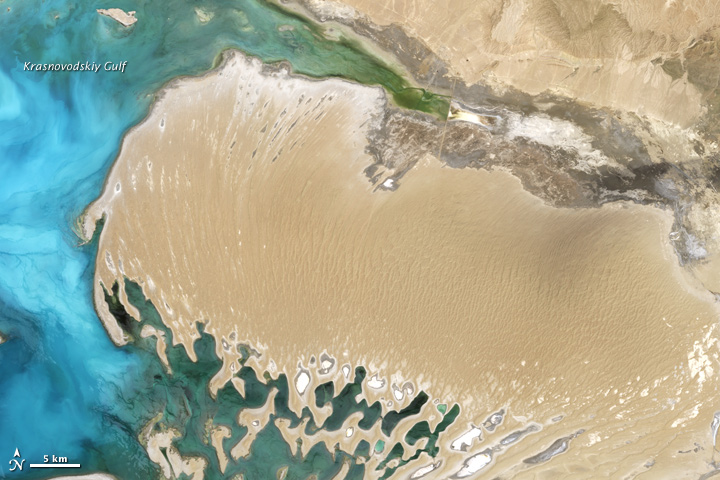NASA: Turkmenistan - Dardzha Peninsula + USGS NASA Photo - 02.06.12
Posted by Ricardo Marcenaro | Posted in NASA: Turkmenistan - Dardzha Peninsula + USGS NASA Photo - 02.06.12 | Posted on 20:25

acquired June 16, 2000
download large image (3 MB, JPEG, 3000x3000)
acquired June 16, 2000
download GeoTIFF file (18 MB, TIFF)
Part of a country mostly covered by
desert, the Dardzha Peninsula lies along the shore of the world’s most
expansive inland water body. Pushing westward into the Caspian Sea from
Turkmenistan’s Garagum (Karakum) Desert, the Dardzha Peninsula is a
landscape of sand dunes and salt flats. The Enhanced Thematic Mapper
Plus on the Landsat 7 satellite acquired this natural-color image of the
peninsula on June 16, 2000.
Dunes on the peninsula are long, linear features stretching mostly
north-south. Toward the east, the dunes transition to level, sandy
plains. Along the peninsula’s southern edge lies a network of partially
submerged dunes, interspersed with shallow, salty lakes. These dunes
separate the Dardzha from a neighboring peninsula, the Cheleken.
A river known as the Uzboy used to flow through the Garagum Desert
toward the Caspian Sea. Exactly when the river dried up is a matter of
debate, but when the river was active, its estuaries periodically
flooded. The flooding deposited vast quantities of sand, eventually
forming the Dardzha Peninsula. Today, winds blowing over the Garagum
Desert can pick up dust that is later deposited on arable lands of the Volga River Valley, impeding agriculture.
Partially driven by human activities such as river damming, falling
water levels in the Caspian Sea contributed to the buildup of silt on
the Dardzha Peninsula, especially after 1960. The average surface level
of the Caspian is 27 meters (89 feet) below sea level. In the late
nineteenth century, the water level started falling, bottoming out in
the late 1970s before rebounding. During the long period of declining
water levels, people around the Caspian Sea grew accustomed to the low
water, so when water began rising, it displaced some settlements and
infrastructure that had developed along the shores. The Dardzha
Peninsula, however, rarely supported much human activity, its salty
soils being unsuitable for agriculture, grazing, or big structures.
- References
- CIA World Factbook. (2012, April 26) Turkmenistan. Accessed May 18, 2012.
- Earth as Art 3. (2011, February 6) The Dardzha Monster. U.S. Geological Survey. Accessed May 18, 2012.
- Flying Camera Images – 2006. Dune landscapes on the Dardzha Peninsula. McMaster University. Accessed May 18, 2012.
- United Nations Environment Programme. (2011) Cyclic fluctuations in the level of the Caspian Sea. Accessed May 18, 2012.
NASA Earth Observatory image by Jesse Allen and Robert Simmon, using Landsat data from the United States Geological Survey. Caption by Michon Scott.
- Instrument:
- Landsat 7 - ETM+
Ricardo M Marcenaro - Facebook
Operative blogs of The Solitary Dog:
solitary dog sculptor:
http://byricardomarcenaro.blogspot.com
Solitary Dog Sculptor I:
http://byricardomarcenaroi.blogspot.com
Para:
comunicarse conmigo,
enviar materiales para publicar,
propuestas:
marcenaroescultor@gmail.com
For:
contact me,
submit materials for publication,
proposals:
marcenaroescultor@gmail.com
Diario La Nación
Argentina
Cuenta Comentarista en el Foro:
Capiscum
My blogs are an open house to all cultures, religions and countries. Be a follower if you like it, with this action you are building a new culture of tolerance, open mind and heart for peace, love and human respect.
Thanks :)
Mis blogs son una casa abierta a todas las culturas, religiones y países. Se un seguidor si quieres, con esta acción usted está construyendo una nueva cultura de la tolerancia, la mente y el corazón abiertos para la paz, el amor y el respeto humano.
Gracias :)



Comments (0)
Publicar un comentario